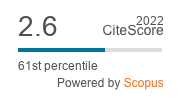Territorial Cohesion in the Context of Interregional and Transnational Cooperation
DOI:
https://doi.org/10.2478/v10105-010-0001-9Keywords:
EU, territorial cohesion, integrative planningAbstract
Territorial cohesion can be traced back to the making of the European Spatial Development Perspective. Therefore, the experience gained with the application of this ‘mother document’ (Faludi in Krupa et al., 2008, p. 14) of integrative planning in Europe can contribute to the specification of territorial cohesion.
This paper draws on experience from the Interreg IIIC project ProgreSDEC, covering local and regional authorities from Greece, Italy, and Spain cooperating with each other in interregional and transnational projects. It looks both at the vertical and horizontal dimensions of European integration and explains three aspects of territorial cohesion. Talking about growing awareness, it should be differentiated between awareness relating to European issues – such as the European territorial and institutional environment – to the quality of planning, and to the endogenous ‘territorial capital’. Key terms of European integrative planning are interpreted differently. The paper discusses the reading of ‘polycentricity’, ‘landscape’, and ‘governance’, in particular. Territorial governance can be looked at as an institutional approach to develop integrative planning in the context of territorial cohesion. This notably turns the attention to regions as the focus of integration, in terms of balancing sectoral approaches, bundling spacious networks, and handling the demands from different levels.
Downloads
References
BÖHME, K. and SCHÖN, P. (2006), ‘From Leipzig to Leipzig’, disP, 165, pp. 61-70.
Google Scholar
CEC (Commission of the European Communities), (1999), European Spatial Development Perspective (ESDP). Towards Balanced and Sustainable Development of the Territory of the European Union, Luxembourg.
Google Scholar
CEC (Commission of the European Communities), (2008), Green Paper on Territorial Cohesion. Turning Territorial Diversity into Strength, Communication from the Commission to the European Parliament, the Council, the Committee of the Regions and the European Economic and Social Committee, COM, 616 final, Brussels.
Google Scholar
ESPON Project 2.3.1 (2007), Application and Effects of the ESDP in the Member States, Final, revised report (version January).
Google Scholar
ESPON Project 2.3.2 (2007), Governance of Territorial and Urban Policies from EU to Local Level, Final, revised report (version February).
Google Scholar
EU MINISTERS FOR SPATIAL PLANNING AND DEVELOPMENT (2007), Territorial Agenda of the European Union. Towards a More Competitive and Sustainable Europe of Diverse Regions, Agreed on the Occasion of the Informal Ministerial Meeting on Urban Development and Territorial Cohesion in Leipzig on May 24th/25th.
Google Scholar
FALUDI, A. (2009), ‘A Turning Point in the Development of European Spatial Planning? The "Territorial Agenda of the European Union" and the "First Action Programme"’, Progress in Planning 71, pp. 1-42.
Google Scholar
FALUDI, A. and WATERHOUT, B. (2002), The Making of the European Spatial Development Perspective. No Masterplan, London, New York: Routledge.
Google Scholar
GEORGE, S. (2005), ‘Multi-level Governance and the European Union’, [in:] BACHE, I. and FLINDERS, M. (eds), Multi-level Governance, Oxford: Oxford University Press, pp. 107-126.
Google Scholar
GIANNAKOUROU, G. (2005), ‘Transforming Spatial Planning Policy in Mediterranean Countries: Europeanization and Domestic Change’, European Planning Studies, 13 (2), pp. 319-331.
Google Scholar
GUALINI, E. (2008), ‘"Territorial Cohesion" as a Category of Agency. The Missing Dimension in the EU Spatial Policy Debate’, European Journal of Spatial Development, Refereed Articles, 28.
Google Scholar
JANIN RIVOLIN, U. (2005a), ‘The Future of the ESDP in the Framework of Territorial Cohesion’, disP, 2, pp. 19-27.
Google Scholar
JANIN RIVOLIN, U. and FALUDI, A. (2005b), ‘The Hidden Face in European Spatial Planning: Innovations in Governance’, European Planning Studies, 13 (2), pp. 195-215.
Google Scholar
KOHLER-KOCH, B. (2002), ‘European Networks and Ideas: Changing National Policies?’, European Integration Online Papers (EioP), 6 (6).
Google Scholar
KRUPA, J., KUNKEL, K. and STEIN, A. (2008), Ein halbes Jahr Territoriale Agenda - Wegweisend für die Raumentwicklungspolitik? Dokumentation der Fachkonferenz am 11. Dezember 2007 in Potsdam http://www.irs-net.de/forschung/forschungsabteilung-1/progresdec/ProgreSDEC_Dokumentation.pdf last access: 3 December 2009.
Google Scholar
KUJATH, H. J. and STEIN, A. (2009), ‘Spatial Patterns in the Knowledge Society’, [in:] KILPER, H. (ed.), German Annual 2009. New Disparities in Spatial Development in Europe, Heidelberg: Springer, pp. 37-50.
Google Scholar
NEWMAN, P. and THORNLEY, A. (1996), Urban Planning in Europe. International Competition, National Systems & Planning Projects, London, New York: Routledge.
Google Scholar
PRIEMUS, H. and ZONNEVELD, W. (2004), ‘Regional and Transnational Spatial Planning: Problems Today, Perspectives for the Future’, European Planning Studies, 12 (3), pp. 283-297.
Google Scholar
ProgreSDEC (2008), Final Report, Version as of 27 May, 2008. http://www.progresdec.org/intranet/documents/PROGRESDEC%20Final%20Report.pdf last access: December 3rd, 2009.
Google Scholar
SYKES, O. (2008), ‘The Importance of Context and Comparison in the Study of European Spatial Planning’, European Planning Studies, 16 (4), pp. 537-555.
Google Scholar
WILLIAMS, R. W. (2000), ‘Constructing the European Spatial Development Perspective - For Whom?’, European Planning Studies, 8 (3), pp. 357-365.
Google Scholar
Downloads
Published
How to Cite
Issue
Section
License

This work is licensed under a Creative Commons Attribution-NonCommercial-NoDerivatives 4.0 International License.














